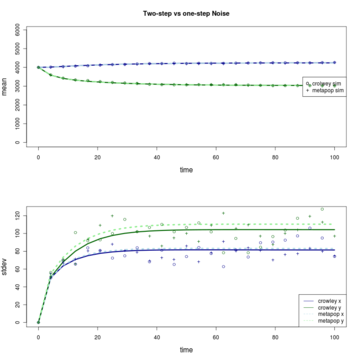- Wasn’t taking the Jacobian of the transition terms. Fixes the unstable behavior and disagreement between simulations and theory.
- Other note: the “hastings.c” model can trivially be obtained from the standard crowley-form metapopulation model by taking b_1 = 0.
For the crowley class of models at least, seems that while the two-step vs one-step involved different dynamics, this difference exists only in transients while equilbrium covariances agree.

- Corrected figures from Friday:


Fig 1. Parameters: b_1 = .2, b_2 = .1, d_1 = d_2 = c = .1


Fig. 2. Parameters: b_1 = .2, b_2 = .1, d_1 = d_2 = .1, c = .15
#### Beetle dynamics
- Variances aren’t exactly in agreement, though much closer. Simulations with 30 replicates a piece for speed, will rerun for finer resolution on variances comparisons.
- Wondering what parameter regimes will make most pronounced difference.
